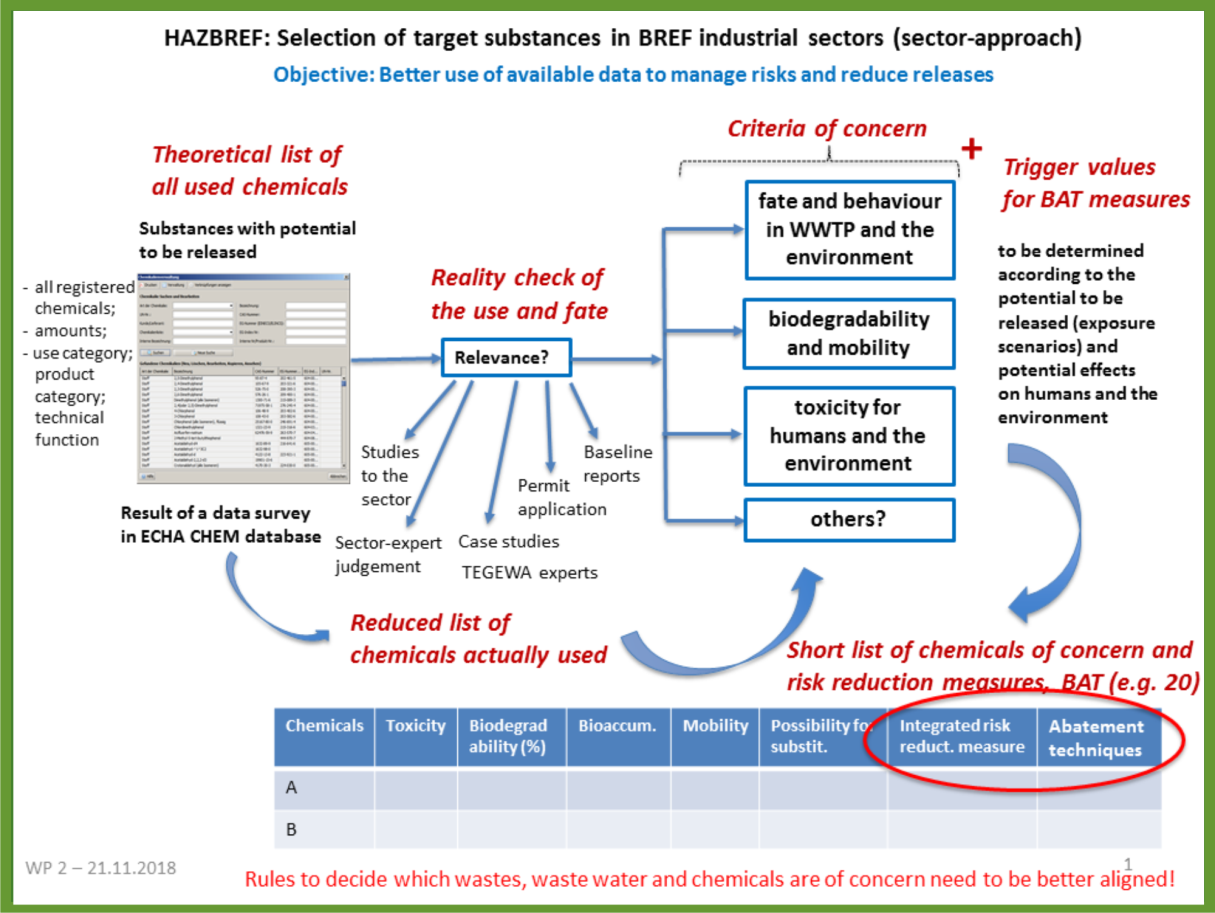|
WP2 report 'Approaches for a better use of available data to prevent or reduce releases of substances of concern from industrial installations' is now available!
Download the report from the Publication page
|
Identification of target substances (Work Package 2)
Leader of the work package is German Environmental Agency (UBA).
This work package consists of two groups of activities:
- Selection of target substances
- Fate of substances during emission treatment.
The aim of the work package was to develop a systematic approach to identify the hazardous substances relevant for each IED industrial sectors and which should be considered in the review process of the BAT Reference Documents (BREFs). The identification of the relevant substances will be done by utilizing already existing information.
For the time being there is no procedure existing by which the already available knowledge on hazardous substances can be included in BREFs in a systematic way. There is also not knowledge on which substances might be relevant to be reflected in the BREFs. However, the BREFs should include the latest information on hazardous substances and the measures to reduce the releases. This is the gap that HAZBREF aimed to fill by the activities in this WP.
Selection of target substances
The activity aimed to identify relevant substances for each IED industrial sector and which should be considered in the review process of the BREFs. HAZBREF project decided to use three strategies to pinpoint the relevant chemicals of concern in each of the selected sectors. First, we will searched for relevant chemicals in the ECHA database according to the use categories and technical functions of individual chemicals and chemical groups. The next step was to evaluate the fate and behavior of these chemicals in the industrial installations and wastewater treatment in order to determine their potential to be released to the environment. If, in addition, a substance has intrinsic hazardous properties, such as toxicity to humans or environment, the need of risk reduction measures and abatement techniques at the industrial sites increases.
One outcome is a tool which will help both authorities and industrial installations to address the relevant substances in order to have proper measures applied. The tool (interactive scheme) can be used here.

Selection of target substances for each sector from ECHA's chemical database. © Johann Moltmann
Substances of Very High Concern and Water Framework Directive Priority Substances
HAZBREF recommends that it should be assessed if regulated hazardous substances are used in a sector for which a BREF review is carried out. In the HAZBREF project this assessment was done for Substances of Very High Concern (SVHC) and Water Framework Directive Priority Substances (WFD PS).
The list of SVHC substances was downloaded from the ECHA webpage. At the moment of making the exercise (April 2020), the list included 205 substances or substance groups identified as SVHC. The information on the substance uses in EU was compiled from the public ECHA database and in Nordic countries from SPIN register (Substances in Preparation in Nordic countries). The results for some of the IED sectors are presented in the excel table, which you may download from the link below. Please note, that the table will not be updated and the information in the table is not verified but is based on the public information in the ECHA database and SPIN register.
The possible uses of SVHCs and WFD PSs in different BREF sectors (xlsx-file)
Fate of substances during emission treatment
Not all substances in industrial process that goes to waste water are relevant to be included in BREFs. For example substances that degrade in waste water treatment plant (WWTP) are probably no risk for the environment and the Baltic Sea. Therefore, it is important to assess how big fraction of the hazardous substance will finally be released to the environment (i.e. pass the waste water without change or that adsorb on WWTP sludge).
Contact Persons:
-
Work Package leader: Nannett Aust (UBA) nannett.aust(a)uba.de
-
Activity 2.1. leader: Johann Moltmann and Jürgen Fischer (UBA) jfm.natkom(a)online.de and juergen.fischer(a)uba.de
-
Activity 2.2. leader: Annika Månsson (SWE EPA) annika.mansson(a)naturvardsverket.se